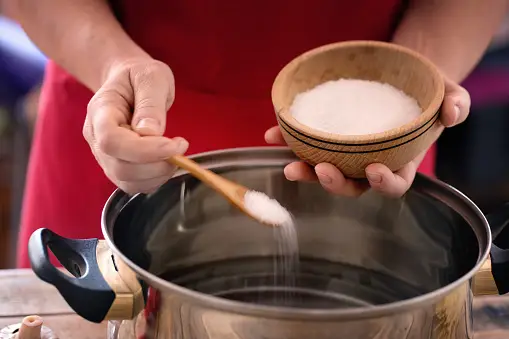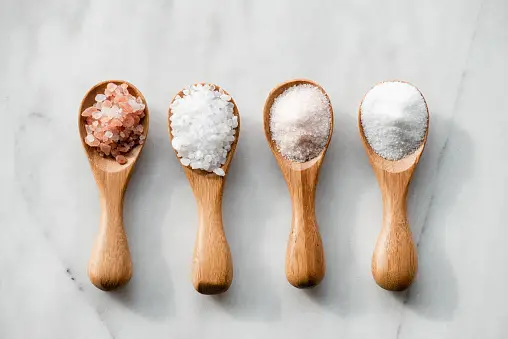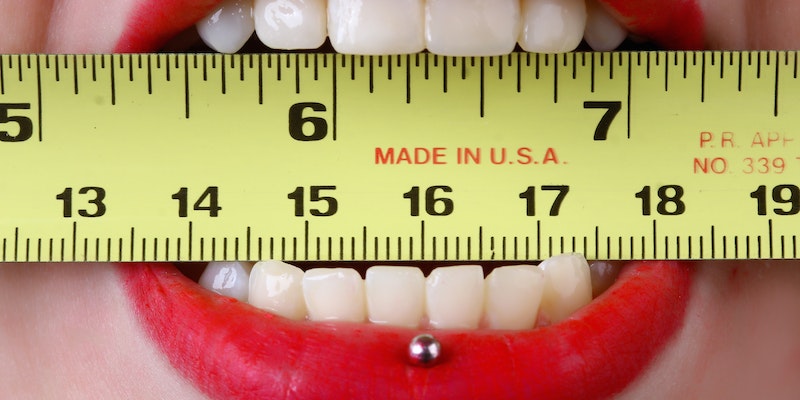Benefits Of Adding Sea Salt To Your Diet
Jan 27, 2024 By Nancy Miller
Do you want to take your health and nutrition to the next level? Are you interested in incorporating more natural products into your lifestyle? If so, adding sea salt to your diet may be beneficial. Sea salt contains trace elements and minerals that can help support many aspects of health and nutrition.
The mineral profile of sea salt helps with improved digestion, better blood circulation, and stronger immunity and provides most of the essential electrolytes our bodies need for optimal functioning. In this article, we will explore all these benefits in detail.
Sea Salt

Sea salt is a type of mineral-rich salt that comes from evaporated seawater. It's harvested from the sea and dried in large pans or kettles to produce its natural crystal look and texture.
Unlike table salt, with minerals removed, sea salt contains all the beneficial trace elements and minerals naturally found in the ocean, including magnesium, calcium, potassium, and bromide.
Benefits Of Sea Salt
- Improved Digestion: Sea salt helps to stimulate digestive enzymes, which can help break down food faster for better digestion. Trace minerals also play an important role in helping your body absorb essential nutrients more effectively.
- Better Blood Circulation: The minerals in sea salt help improve circulation and can help reduce blood pressure.
- Natural Detoxification: Sea salt helps to draw out toxins from the body, making it easier for your body to flush them out naturally.
- Stronger Immune System: The trace minerals found in sea salt help to strengthen your immune system, helping you stay healthy and fight off colds and other illnesses more easily.
- Increased Metabolism: As well as supporting your digestive system, the minerals in sea salt can also help boost your metabolism, making it easier to burn fat and lose weight.
- Improved Bone Strength: The calcium and magnesium in sea salt are essential for strong bones and teeth.
- Balanced Electrolytes: Sea salt contains the essential electrolytes our bodies need for optimal functioning.
- Improved Sleep: The minerals and trace elements found in sea salt can help improve your sleep quality, helping you feel more rested throughout the day.
- Reduced Cravings: The minerals in sea salt help to balance out cravings from unhealthy foods, making it easier to stay on track with your healthy eating habits.
- Balanced pH Levels: Sea salt helps to balance out pH levels in the body, which is important for overall health and well-being.
Adding some sea salt to your diet could be a great way to improve your health and nutrition. Remember to always use unrefined or minimally processed sea salt, as this will ensure you get all the beneficial minerals and trace elements.
Different Types of Sea Salt

Although all types of sea salt benefit health and nutrition, some are more mineral-rich than others. Here is a rundown of the different varieties:
Himalayan Pink Salt
Himalayan pink salt is among the highest quality sea salts available, containing over 84 minerals and trace elements. It has a light pink color due to its natural iron content.
Celtic Sea Salt
This type of sea salt comes from Brittany, France, and is harvested using traditional Celtic methods from seawater evaporating in clay pots under the sun. It contains trace amounts of magnesium and calcium which can help support healthy blood pressure levels and improve digestion.
Atlantic Sea Salt
This sea salt is harvested from the Atlantic Ocean and contains a higher mineral content than other types of sea salt. It has a slightly coarser grain and is often used in cooking for flavor.
Fleur de Sel
Fleur de sel is a very fine sea salt hand-harvested from the top layer of French seawater. It's highly prized for its unique texture, flavor, and mineral content.
Hawaiian Black Salt
This type of sea salt originates from Hawaii and has been processed to produce a distinctive black color due to its volcanic ash content. It has a mild salty flavor and adds an interesting taste to many dishes.
No matter what type of sea salt you choose, adding it to your diet can be a great way to support various aspects of health and nutrition. Be sure to use unrefined or minimally processed sources for the best benefits. Try experimenting with different types to find which one works best for you.
Recipes Incorporating Sea Salt for Better Nutrition
Now that you know the benefits of adding sea salt to your diet, here are some delicious and nutritious recipes incorporating this mineral-rich ingredient.
Sea Salt Roasted Veggies
Preheat oven to 400°F. Cut your favorite veggies into cubes or slices (such as sweet potatoes, carrots, squash, and mushrooms). Put them on a baking sheet lined with parchment paper and sprinkle them with olive oil, sea salt, and other herbs or spices you like. Bake for 20 minutes until veggies are lightly browned and cooked through. Enjoy!
Sea Salt Avocado Toast
Toast 2 slices of whole wheat bread in a toaster or grill pan. Mash 1/2 an avocado onto each slice of toast and sprinkle with sea salt. Top with tomatoes, arugula, and a squeeze of lemon juice for a nutritious breakfast or snack.
Salted Caramel Popcorn
Put 1/2 cup of popcorn kernels in a pot with 1 tablespoon of coconut oil. Cover the pot and cook over medium heat, shaking occasionally until the popcorn is popped. Remove from heat and place the popcorn in a large bowl, drizzle with melted coconut oil, and then sprinkle with sea salt to taste.
Sea Salt Dark Chocolate Bark
Line a baking sheet with parchment paper and spread 12 ounces of dark chocolate chips on top. Sprinkle liberally with sea salt flakes (or finely ground sea salt). Place in the fridge for at least 30 minutes until set. Break into pieces and enjoy.
Spicy Sea Salt Edamame
Bring a pot of lightly salted water to a boil. Add 1/2 pound of frozen edamame and cook for 5 minutes. Drain and transfer to a bowl, then toss with olive oil, garlic powder, cayenne pepper, and sea salt to taste.
Sea salt is an incredibly versatile ingredient that can enhance your meals' taste and nutritional value. With these recipes, you'll reap the benefits of this mineral-rich ingredient while enjoying some delicious dishes.
Important Considerations When Choosing and Using Sea Salt
While there are many benefits to adding sea salt to your diet, there are also some important considerations to remember. Here are a few tips to help you choose and use the best quality sea salt:
FAQS
How much sea salt per day is healthy?
Adults' recommended daily sea salt intake is about one teaspoon, but this can vary depending on age and health status. The best way to ensure you're not overdoing it is to season food lightly and add more if needed.
What is the difference between table salt and sea salt?
Table salt is mined from underground deposits and is heavily processed, often including additives such as anti-caking agents. Sea salt, on the other hand, is harvested from evaporated seawater and usually retains most of its natural minerals and trace elements.
How can I check my sodium level at home?
The easiest way to check your sodium level at home is to buy a home test kit which will allow you to take a sample of your urine or saliva and measure the amount of sodium present.
Conclusion
Sea salt has been used as a seasoning for culinary purposes for centuries and is still popular today. The many benefits of adding sea salt to your diet range from weight management to improved digestion and skin health. Adding sea salt to your favorite dishes can add a burst of flavor on top of all the health benefits of it. It's important to practice moderation when using sea salt for cooking or flavoring purposes, as it can contribute to high sodium levels in the body.

Appreciate Your Emotions: Learn How To Survive With a Sensitive Heart

Teeth whitening tips and tricks are all over the internet, and in this article, we have compiled the best ones for you.

A Closer Look at the Rise of Advanced Stage Cervical Cancer

Selenium Explored: Health Benefits, Dietary Sources, Recommended Dosage, and Risks

Battling Neck Pain: Identifying Causes and Finding Relief

Unmasking Pneumonia: The Basics

Comparing the Efficacy of Spray Sunscreen and Lotion


